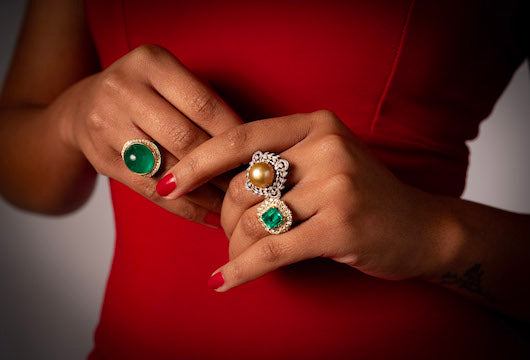
The before and after image above is a perfect example of why cut is so important
in the world of colored gemstones.
Precious gemstones are a miracle of nature. Formed by the earth, these natural wonders take thousands of years to come to fruition, enduring tremendous heat, pressure, and geological processes before emerging from the ground. While a select few, like “nat thwe” spinel crystals, emerge in beautiful octahedral crystal formations, most gems require the intervention of man to unleash their full potential as the jewels we embrace today.
Well-cut gems not only showcase the natural clarity and color of a stone, they also highlight its brilliance by directing light into the stone’s facets and bouncing it back to the surface. A good lapidary artist’s work shows some evidence of smoke and mirrors – a dark, dead sapphire suddenly has sparkle and vibrant coloring thanks to a shallower cut, while a pale, tepid stone can be cut deeply to intensify its color. The gem cutting trade encompasses the mastery of illusion, and good gem cutters are experts at manipulating how we perceive color in a gemstone.

It is hard to believe that the minty-toned pebbles above will become sparkling sapphire gems, but the image underscores the point: cut is EVERYTHING.
From Rough to Polished Gemstone
A lapidary artist painstakingly examines each piece of gem rough for inclusions, color zoning, and the presence of cleavage planes before determining his cutting strategy. Ideally, he will produce the highest yield possible, while minimizing visible inclusions and color inconsistencies. As he explores the stone, identifying its strengths and weaknesses, he begins to preform its shape, a process which entails grinding the rough by hand to determine its final form.
Next, the crudely formed gemstone is affixed to the end of a wooden or metal stick with wax. The stick, known as a dop stick, holds the stone securely at the angle necessary for the next phase of faceting.
Once firmly attached to the dop, the stone is pressed against a rapidly spinning wheel covered in diamond dust. This disk, known as a lap, grinds away the stone material to produce the facets. The dop can be affixed above the lap, or it can be held by hand. Although nearly all setups consist of some mix of this configuration, the technical components and sophistication vary dramatically – from rudimentary systems with foot pedals and hand-held dops, to multi-million dollar, laser enabled state-of-the-art equipment. In either case, the gemstone is subjected to a series of lap discs, each covered in progressively finer grit until the top and bottom facets have been fixed and polished on the stone.

By choosing to cab this moonstone, the cutter has emphasized the adularescence of the beautiful gem that would be barely visible in a facteted cut.
Types of Cut
Most faceted gems have a crown, girdle, and pavilion. Fantasy cuts and native cuts both have irregularly placed facets in addition to these – the former as a design element and the latter to facilitate weight retention and color. As mentioned above, the primary function of facets and facet junctions is to shape the intake of light and its return outwards when viewed from above.
The three cutting types most frequently seen are brilliant, step, and mixed.
Brilliant cut gems are composed of kite-shaped and triangular facets fanning out from the center of the stone. This cut typically has 58 facets, or polished planes. Brilliant cut gemstones are the most popular of the faceting styles because the cut creates the highest level of sparkle, or scintillation.
Step cuts are composed of a series of rectangular facets that “step” up the crown and down the pavilion. Popular step cuts include emerald, asscher, and baguette cuts. Step cuts are appreciated for their subtle elegance and are frequently used to emphasize a gem’s clarity.
Mixed cuts combine brilliant cut and step cut layouts within a single gemstone in various combinations. For example, they may have step cuts on the crown with brilliant cuts on the pavilion.
Conversely, cabochon gems are polished into a smooth, rounded dome with an absence of facets. Gemstones that display unique visual properties like cat’s eye, asterism, and adularescence are well suited for this cut. For example, moonstone, opal, and tiger’s eye are all good candidates for this cutting style. Cabbing may also be used if a stone is too opaque for faceting or if the gem is heavily included, because the style emphasizes luster rather than sparkle.
A gifted lapidary artist will judiciously apply these styles after evaluating the gem’s intrinsic characteristics to create the most appealing visual arrangement and greatest weight retention.

To ensure a quality cut, each gemstone must be carefully assessed for color saturation, inclusions, and cleavage.
Cut Considerations and Trade-Offs
Within the scope of the options listed above, the depth of the stone and facet placement can be heavily influenced by the individual characteristics of each gem. In some cases, rough yield of a finished gemstone can be as high as 50%, but typically that number will be much lower. As a cutter makes his plan, must weigh out the value of the finished design. For example, will the rough produce higher profits as several smaller, relatively inclusion free gemstones, or will it hold more value as a larger gem with more inclusions and less consistent color? Each decision is made on a case-by-case basis.
To further complicate matters, the color intensity of a gemstone can vary substantially as its size and proportions increase or diminish – but this can also be employed as a tool in the cutter’s favor. For example, a more delicately colored piece of rough can be extremely desirable if cut in a way that allows it to produce enough color saturation. In that case, the cutter may cut a deeper than normal stone to allow for penetration by the light. But if he cuts the stone too deeply, the light extinguishes entirely, resulting in a flat, lifeless gem.
On the opposite end of the spectrum, an excessively dark gem can be greatly improved by a shallower pavilion angle, but if the angle is shortened too severely, light passes through the stone without being bounced back in any direction by the pavilion facets, creating a window, or dull, flat areas in the center of the stone.
The better a cutter’s comprehension of the way that these factors interact within each gem, the more skilled he becomes at coaxing the best color and brilliance from each stone. How a cutter manages the passage of light through a gemstone is a delicate dance that requires great dexterity and skill.
A well-proportioned gem can not only have a significant impact on the value of the gemstone, it ensures that the finished jewel looks good to the dealer and ultimately the customer. But what are the other factors that contribute to ideal proportions? To continue this discussion and learn more about the importance of symmetry, facet meets, and other important quality indicators, read part 2 of this series: Gemstone Cut Quality Indicators.


